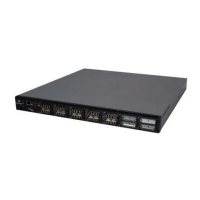3 – Planning
Multiple Chassis Fabrics
3-6 59265-00 A
S
Multiple Chassis Fabrics
By connecting switches together you can expand the number of available ports for
devices. Each switch in the fabric is identified by a unique domain ID, and the
fabric can automatically resolve domain ID conflicts. Because the Fibre Channel
ports are self-configuring, you can connect SANbox 5802V switches together in a
wide variety of topologies.
You can connect up to six SANbox 5802V switches together through the XPAK
ports, thus preserving the SFP ports for devices. This is called stacking. SANbox
5802V switches divide the XPAK port buffer to balance traffic across the
connection. The XPAK ports operate with any standard XPAK interface. You can
also connect SANbox 5802V switches with other switches through the SFP ports
in a wide variety of topologies. Consider your topology and cabling requirements.
Optimizing Device Performance
When choosing a topology for a multiple chassis fabric, you should also consider
the locality of your server and storage devices and the performance requirements
of your application. Storage applications such as video distribution, medical record
storage/retrieval or real-time data acquisition can have specific latency or
bandwidth requirements.
The SANbox 5802V switch provides the lowest latency of any product in its class.
Refer to “Performance” on page 3-3 for information about latency. However, the
highest performance is achieved on Fibre Channel switches by keeping traffic
within a single switch instead of relying on ISLs. Therefore, for optimal device
performance, place devices on the same switch under the following conditions:
Heavy I/O traffic between specific server and storage devices.
Distinct speed mismatch between devices such as the following:
A 8-Gbps server and a slower 4-Gbps storage device
A high performance server and slow tape storage device

